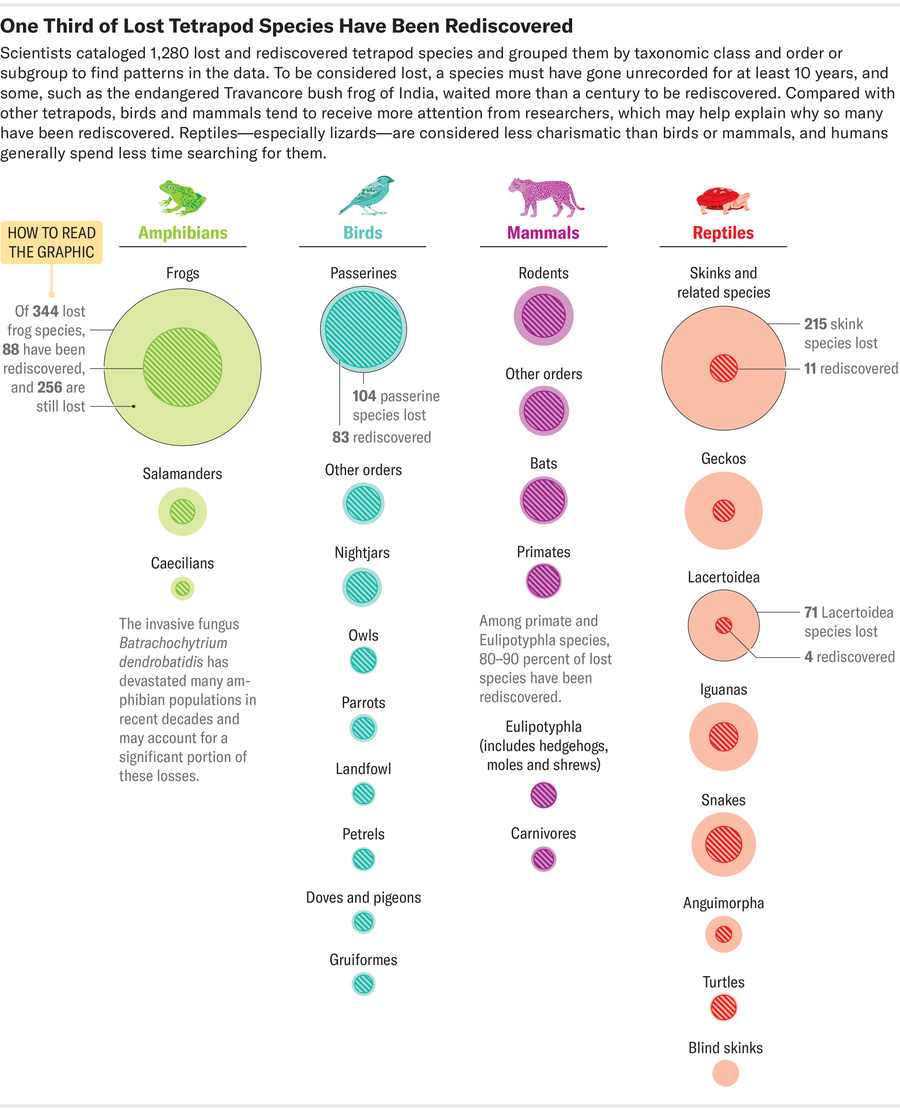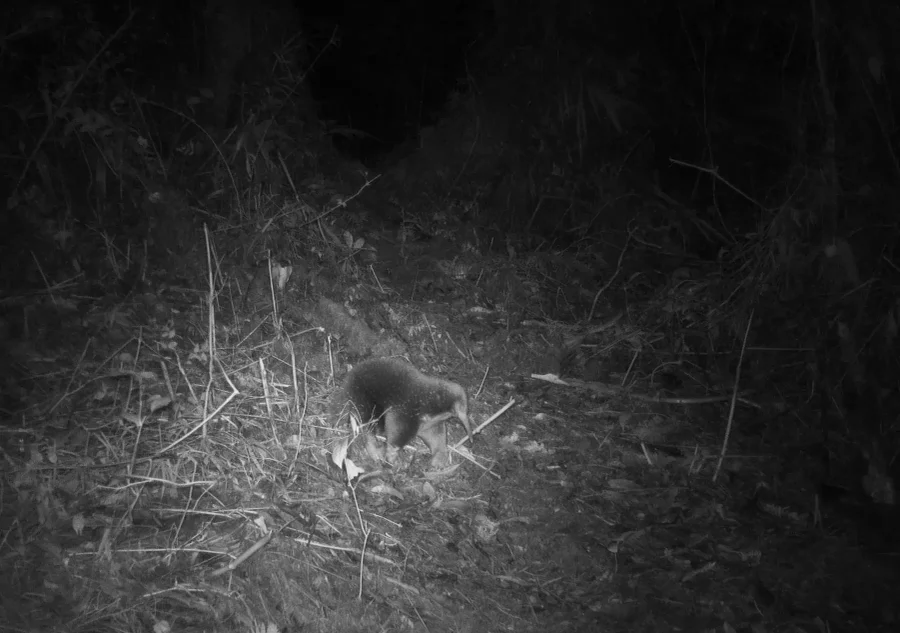Gison Morib was lying in bed, sick from exhaustion after a month-long jungle expedition, when his phone buzzed, revealing a black-and-white photograph of a long-nosed, fuzzy animal. Morib ran outside, jumped on his motorbike and sped through the city of Sentani in Indonesian New Guinea to his colleagues’ expedition and research base, where he broke down in tears. “I cannot believe we found it,” was all he could say, over and over. After three years of study and four weeks trekking through the island’s remote Cyclops Mountains—and after one leech attached itself to Morib’s eyeball—the team had finally captured, via camera trap, the first recorded sighting in more than 60 years of Attenborough’s long-beaked echidna. “Even now I can’t describe the feeling when we got it,” says Morib, a biology undergraduate student at the local Cenderawasih University. “I cannot describe the goodness of God.”
It can be painful for scientists to conclude that an entire species is gone forever. So after at least a decade without recorded sightings, local researchers sometimes declare a species temporarily “lost,” hoping it may eventually be found again. In 2023 that hope led to rediscoveries of animals that included Attenborough’s echidna, De Winton’s golden mole in South Africa and the Victorian grassland earless dragon, a type of Australian lizard that went unseen for half a century. Such hope also fuels ongoing, decades-long searches for species such as the American Ivory-billed Woodpecker, which was last seen in 1944.
Now an international study published in Global Change Biology aims to “bring a bit of science to the search” for the mammals, amphibians, reptiles and birds playing hide-and-seek, according to senior study author Thomas Evans, a conservation scientist at the Free University of Berlin. Evans and researchers around the globe—in the U.S., China, Ecuador, South Africa, and more—spent two years compiling what they call the most exhaustive catalog ever of four-limbed creatures considered lost to science, as well as those that have been rediscovered.
On supporting science journalism
If you're enjoying this article, consider supporting our award-winning journalism by subscribing. By purchasing a subscription you are helping to ensure the future of impactful stories about the discoveries and ideas shaping our world today.
The project started when Evans read “a huge, great, really depressing book” called Extinct Birds by paleontologist Julian P. Hume. Along with the grim detail, the book came with a sliver of hope: an appendix listing lost species that were eventually found. Although there has been plenty of research into lost species, the study authors say that rediscoveries haven’t been thoroughly assessed since 2011. Analysis tallying losses and rediscoveries across animal groups is even rarer, Evans says.
The catalog Evans and his colleagues created indicates that 856 species are currently missing. And this number is growing faster than expedition parties can keep up with, despite increasingly sophisticated technology for identifying evidence of unseen creatures—including systems that detect environmental DNA traces of burrowing birds near the South Pole, software that disentangles the noises of different nocturnal species, and even techniques used to spot microscopic remnants of rare frogs in ship rats’ stomachs.

Credit: Amanda Montañez (circles), Brown Bird Design (animals); Source: “What Factors Influence the Rediscovery of Lost Tetrapod Species?” by Tim Lindken et al., in Global Change Biology. Published online January 17, 2024
Adding up losses and rediscoveries also suggests that roughly a quarter of lost species are likely already extinct. “It’s kind of sad to think,” Evans says, “but as far as we’re concerned, people aren’t going to find them.” Analysis shows that many rediscovered species fit a certain profile: they are big, charismatic mammals or birds that tend to live across a range of habitats, often near humans and in more-developed countries. So, Evans says, if an animal fits this bill but continues to evade researchers after long searches, it is probably gone forever. The thylacine, or Tasmanian tiger, is a good example: since the last captive thylacine died in a zoo in 1936, the wolflike marsupial has inspired decades of fruitless searching. That fact strongly suggests that the thylacine is actually extinct, Evans says, along with more than 200 other lost species that have also been thoroughly searched for.
On the other hand, creatures that don’t fit the profile for easy rediscovery, especially reptiles, could still be out there. Because they’re often hard to find and inspire less search effort, small, uncharismatic species are more likely to genuinely be lost but still alive, Evans says. His optimism is backed up by the numbers: new species of small reptiles continue to be discovered at a steady rate, and rediscoveries have boomed, with more than twice as many lost reptiles found between 2011 and 2020 as in the decade before.
The thylacine has acquired a Bigfoot-like status, complete with amateur hunters and highly questionable sightings. Meanwhile reptiles such as the Fito leaf chameleon of Madagascar are probably sitting pretty and waiting to be found. (Scientists haven’t yet reobserved this chameleon, partly because the French explorers who first described it in the 1970s named it “Fito”—a locally common place name that covers vast areas. No one knows where its exact range is, and few have looked.)
A probability analysis of some factors also rang “alarm bells” in different ways for different classifications of lost species, Evans says. Mammals classified as lost on islands, such as the Bramble Cay melomys, a rat lost in 2009 and declared extinct in 2016, are disproportionately likely to be gone for good, compared with mammals in other environments. There’s also a sweet spot for finding birds after they’ve been lost: 66 years, on average. This time span is long enough to raise interest in search expeditions but not so long that the animals would be presumed extinct. So the odds are not good for the more than a dozen bird species that were lost more than a century ago.
Evans hopes such details will help conservationists such as Christina Biggs, who has been curating a list of 25 “most wanted” species for Texas-based charity Re:wild since 2017. “We have limited resources, and we have to make hard decisions on where to put that money,” says Biggs, who is also one of the new study’s 27 co-authors. “We want to prevent the most extinction we possibly can. [Evans’s] research helps to direct us.” Re:wild is currently using the study’s findings to update its 2024 search lists.
But is being found always in a lost species’ best interest? After a rediscovery, it can take months to secure an area from poachers or tourists. The researchers who spotted Attenborough’s long-beaked echidna still have not revealed exactly where they saw it. “In publicizing something you’ve rediscovered, you’re publicizing a food source for hunters,” says biologist James Kempton, who led the echidna-finding expedition and wasn’t involved in the cataloging study. Morib notes that in a dialect of the local Papuan language Tabla, the name for the echidna—amokalo—contains a word for “fat” because of the animal’s desirable taste.

Camera trap photo of Attenborough’s long-beaked echidna. Credit: Expedition Cyclops 2023
Biggs notes, however, that rediscoveries often galvanize protection efforts. “As soon as they’re rediscovered, they go into a pipeline to have [protected area] designations made possible,” she says. “Everything that we do could potentially save an entire other body of species in that same habitat. To me, that’s a very hopeful thing.” For instance, when the call of the Blue-eyed Ground Dove was heard in 2015 in the Brazilian state of Minas Gerais, north of Rio de Janeiro, for the first time in 75 years, it sparked the creation of an 89,000-acre state park. Evans adds that for some of the most elusive species, researchers could use the study to decide if a creature is likely still alive—and then draw broad protected areas around its general region rather than send possibly fruitless expeditions to the area to prove the animal’s existence.
Each extinct species comes with both an ecological and a cultural loss. Near the Cyclops Mountains, the Yongsu Sapari community once used echidnas as a “peace tool” to arbitrate disputes. “If brothers or friends fought, they had to find an echidna,” Morib says—a solution that would be increasingly difficult.
The Hawaiian Crow, extinct in the wild, was thought to carry lost souls to their resting place. Now, outside of captivity, its call is only heard when Indigenous priests repeat a crow-like chant during traditional prayers. “Everything is connected,” Biggs says. “Every single species does matter. It behaves in an ecosystem and fulfills a purpose within it that then underpins all of the life that we have on Earth.”
A version of this article entitled “Lost and Found” was adapted for inclusion in the April 2024 issue of Scientific American. This text reflects that version, with the addition of some material that was abridged for print.
